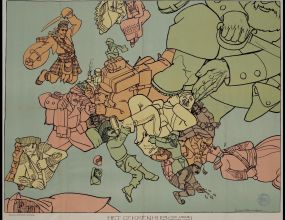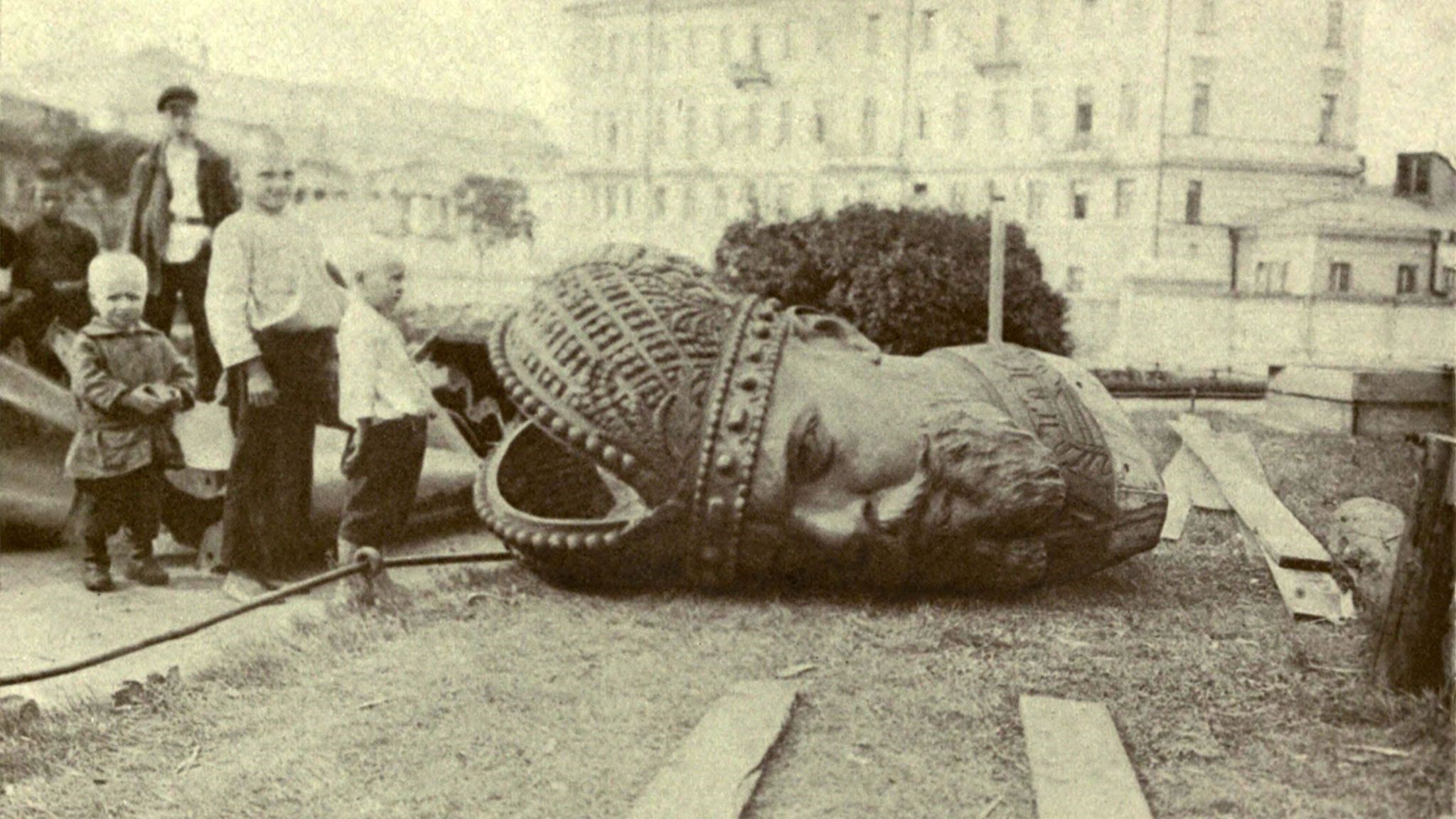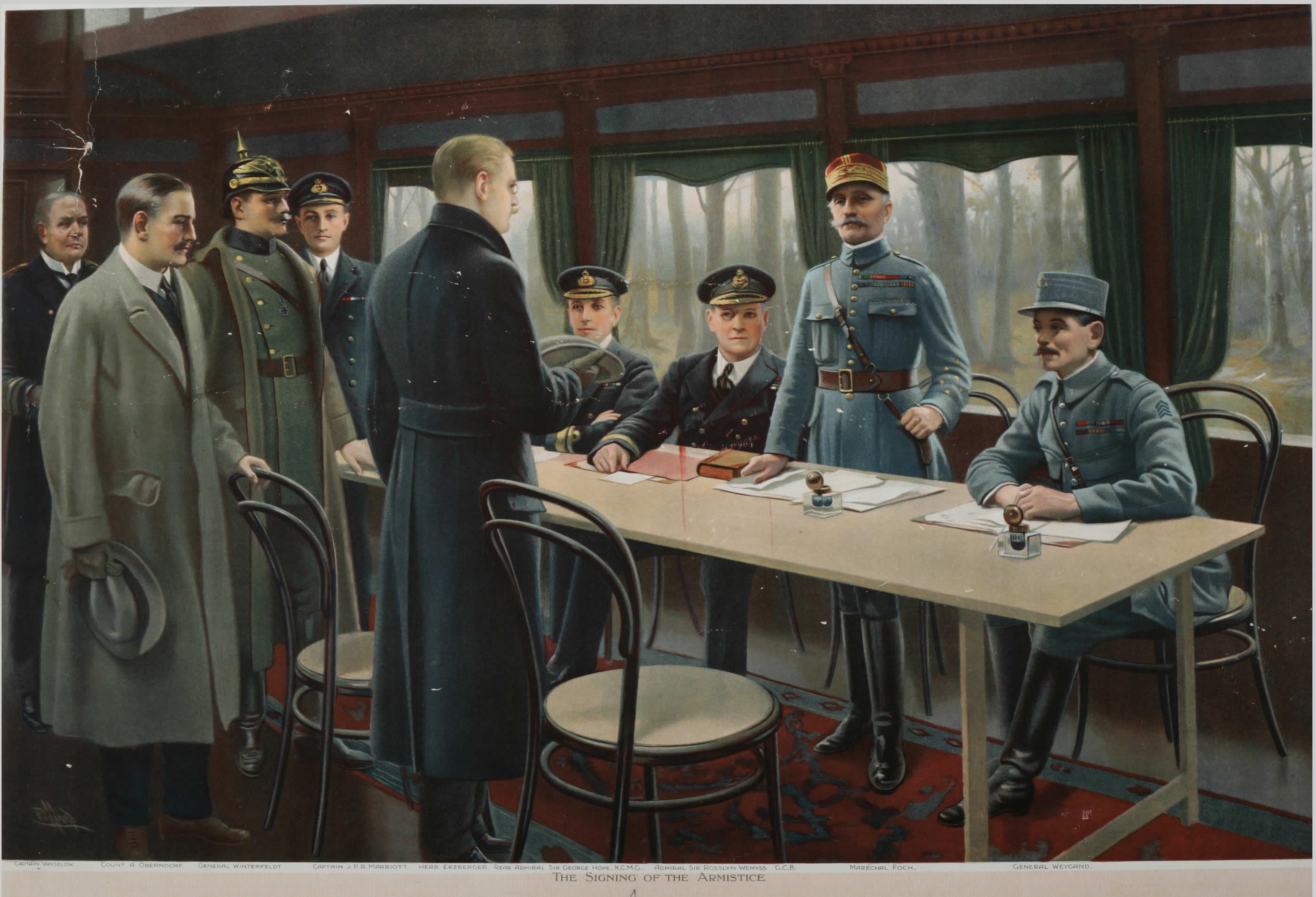
11. studenog 1918. godine u 11 sati je Prvi svjetski rat konačno završio. Nekoliko sati ranije, Njemačka je pristala potpisati primirje pod uvjetima saveznika čime je zaustavljen najkrvaviji sukob u svjetskoj povijesti do tada, koji je oduzeo živote 15 do 20 milijuna ljudi.
Prijevod: Daria Maracheva
Sve je počelo četiri godine ranije u Sarajevu, kad je 28. lipnja 1914. godine mladi srpski nacionalist Gavrilo Princip koji je imao 17 godina, ubio nasljednika austrougarskog prijestolja nadvojvodu Franca Ferdinanda. To je bila iskra koja je izazvala požar Europe. Stoljećima osnaživani nacionalistički osjećaji i oštra konkurencija među zemljama u svim područjima je dovela do situacije da je bilo nemoguće izbjeći sukob. Mjesec dana kasnije, 28. srpnja 1914. godine, Austrougarsko carstvo je napalo Srbiju. Vezane savezničkim obvezama i podržavane od svog nacionalističkog stanovništva, većina europskih vlada je odlučila sudjelovati u ratu. Tako je izbio Prvi svjetski rat, koji je zapalio europske zemlje i cijeli svijet u najstrašnijem sukobu koji se dogodio do tada.
Prvi put u povijesti, ljudi širom svijeta su bili uključeni u isti sukob. To je postalo moguće uglavnom zbog uključivanja trupa iz kolonijalnih područja Britanskog carstva i Francuske. Među najpoznatijim je Korpus senegalskih strijelaca koji se sastojao od približno 200 000 vojnika iz zapadne Afrike koji su služili u francuskoj vojsci. U britanskoj vojsci u sukobu su sudjelovale četiri kanadske divizije i pet divizija ANZAC iz Australije i Novog Zelanda. ANZAC je odigrao značajnu ulogu na Balkanu. Međutim, neovisne zemlje izvan Europe su se također uključile u rat kao što su na primjer Sjedinjene Američke Države na čelu sa predsjednikom Woodrow Wilsonem koji je odlučio podržati saveznike 1917.godine.
Većina bitaka se odvijala u Europi na različitim ratištima. Na Zapadnom frontu Francuska, Velika Britanija, Belgija i Portugal su se borili protiv Njemačke i Austro-Ugarske. Na Istočnom frontu, Rusko carstvo i Rumunjska su se borili protiv Njemačke, Austro-Ugarske, Bugarske i Osmanskog carstva. Na Balkanskom frontu Srbija, Crna Gora, Francuska, Ujedinjeno Kraljevstvo, Italija, Rumunjska, Rusija
i Grčka su pružali otpor Austro-Ugarskoj, Bugarskoj, Njemačkoj i Osmanskom carstvu. Ipak, bitke su se odvijale i na drugim područjima poput kineskog grada Tsingtao, koji je tada okupirala Njemačka. U Tihom oceanu nekoliko otoka poput Nove Gvineje su također bili poprišta sukoba. Osim toga, širom Afrike su se odvijale žestoke bitke. Neke od njih su bila otvorena sučeljavanja između Antante i Središnjih sila, ali mnoge su bile pobune lokalnog stanovništva protiv kolonizatora.
Konačno, Bliski Istok je bio vrlo važan u sukobu. Ujedinjeno Kraljevstvo je odigralo veliku ulogu u destabilizaciji Osmanskog carstva. Među najpoznatije bitke može se navesti ona oko Sueskog kanala ili zauzimanje Basre u Iraku od strane britanskih trupa uz pomoć vojnika koji su dolazili iz kolonijalne Indije. Današnja teritorijalna podjela regije je uglavnom rezultat sporazuma iz Sevresa, koji je potpisan 1920. godine s ciljem podjele Osmanskog carstva.
Više od bilo kojeg drugog događaja u prošlosti, ovaj rat je promijenio sudbinu Europe i označio je početak gubitka dominacije Starog kontinenta. Svi su se, od poraženih do pobjednika, suočili s katastrofalnim posljedicama. Pandemija Španjolske gripe je povećala ogromne ljudske gubitke u ratu. Ova kombinacija strašnih događaja je utjecala na demografiju kontinenta za nekoliko narednih desetljeća sa svim posljedicama koje su uslijedile. Štoviše, rastuće europske ekonomije su bile uništene tokom četiri godine rata i njima je trebalo vremena da se oporave i da naplate zajmove i dugove. Zbog svih tih razloga, Francuzi su ovaj rat nazvali "Zadnji od zadnjih", što odražava volju ljudi da se više nikada ne susretnu s takvom tragedijom. Sličan izraz "Rat za okončanje svih ratova" su koristili i anglosaksonci.

To je također bilo vrijeme značajnih geopolitičkih promjena. Četiri najznačajnija carstva tog doba su istovremeno nestala. Rusko carstvo je nestalo prvo, čemu je značajno doprijenela Februarska i Oktobarska revolucija 1917. godine kao i građanski rat koji je uslijedio. Austro-Ugarsko carstvo je raspalo 31. listopada 1918. godine jer su poraz i težnja naroda za neovisnošću pokazali zastarjelost ovog modela. Osmansko carstvo je doživjelo istu sudbinu. Užasni poraz i porast turskog nacionalizma je omogućio dolazak na vlast Mustafe Kemala Atatürka, pad Kalifata i osnivanje Republike Turske 1923. godine. Konačno, u Njemačkoj, car Wilhelm II je abdicirao 9. studenog 1918. godine, u vrijeme kad je osnivana Weimarska Republika.
Neka od tih carstava su izgledala vrlo zastarjela u Europi obilježenoj nacionalizmom. U njihovim vojskama su se pripadnici različitih naroda borili da zaštite državu koja ih nije predstavljala. Upravo takva situacija je bila u Austro-Ugarskom carstvu u kojem su živjeli predstvanici brojnih nacionalnih skupina, uključujući Hrvate. To je vrijedilo i za Osmansko carstvo koje su kontrolirali Turci, ali su u njemu također živjeli Armenci, Arapi i drugi. Važno je da su i Romi bili vojnici u vojskama država u kojima su tada živjeli. Mnogi od njih su poginuli ili ranjeni tokom rata.

Nakon rata su nove države uzdigle iz pepela bivših carstava. Općenito, granice su određene na način kako bi poštovale volju i potrebu ljudi za nacionalnim državama. Uz potporu američkog predsjednika Woodrowa Wilsona ovaj nacionalni osjećaj je došao do izražaja u načelu samoodređenja naroda. Čak i u novoosnovanom Sovjetskom Savezu su boljševici podržali pravo naroda na samoodređenje prije nego što su se dokopali vlasti, mada je primjena ovog načela ostala uglavnom mrtvo slovo na papiru. Tako su, nakon potpisivanja nekoliko ugovora, uključujući najvažniji Versajski ugovor 1919. godine, stvorene mnoge neovisne države: Finska, Estonija, Latvija, Litva, Poljska, Čehoslovačka, Austrija, Mađarska i Jugoslavija. Međutim, mnoge europske države nisu uglavnom poštovale manjinska prava čime su stvarale napetost i mržnju među stanovništvom.
Unatoč svim užasima rata, stanje mira koje je postignuto primirjem 1918. godine nije trajalo dugo. Nespremnost Antante činiti ustupke Njemačkoj je rezultirala ugovorem koji je njemačko stanovništvo doživljavalo kao "diktat" i koji je omogućio dolazak na vlast bivšeg vojnika Prvog svjetskog rata Adolfa Hitlera. Osim toga, mnogi su u njemačkoj vojsci smatrali da je poraz posljedica izdaje liberala i komunista, a ne vojnog poraza. Istovremeno, Sjedinjene Američke Države su odlučile da neće promicati svoju ulogu velesile, pa čak nisu pristupile Ligi naroda, međunarodnoj instituciji koja je osnivana na prijedlog Woodrowa Wilsona. Konačno, europske sile nisu shvatile da je njihova nekadašnja slava izblijedila i nastavile su vladati većinom svijeta željeznom šakom kroz kolonijalni model. Tako su u sljedećim desetljećima dva modela totalitarizma - komunizam i fašizam širili svoje ideje u Europi, ponovno stvarajući politički nestabilno okruženje. Konačno, zbog želje Hitlerove Njemačke za osvetom dogodilo se nezamislivo – Drugi svjetski rat.

Više od stoljeća nakon bitaka Prvog svjetskog rata posljedice ove tragedije ostaju vidljive, posebno u Francuskoj. Danas je pogled na krajolik Verduna, na kojem su cijela sela uništena granatama, najbolji način da se prisjetimo strašnih užasa koji su se dogodili tokom ovog rata. Osim toga, spomenici posvećeni poginulim vojnicima su podignuti u više zemalja. Nažalost, više nisu među nama svjedoci ovog sukoba. Ipak, još uvijek je moguće pročitati pisma vojnika, pogledati fotografije bojišnice ili filmove snimljene tokom bitaka. Tako je moguće osjetiti bol i očaj koji su uzrokovani ludošću čovječanstva u to vrijeme.
Danas se Prvi svjetski rat obilježava u mnogim zemljama. Primjer je Srbija u kojoj je Prvi svjetski rat i dalje stup kolektivnog sjećanja zbog svih patnji koje su Srbi proživjeli tokom sukoba poput Albanske golgote ali i konačne pobjede u ratu na strani Antante i stvaranja Kraljevine Srba, Hrvata i Slovenaca. Isto vrijedi i za Francusku, zemlju koja je izgubila najveći broj vojnika i građana unatoč konačnoj pobjedi. Međutim, Prvi svjetski rat i dalje nije toliko u fokusu širom svijeta. Za to postoji nekoliko razloga. Prvi svjetski rat je ostao uglavnom europski sukob, unatoč tome što je imao posljedice širom svijeta. Štoviše, taj rat se još uvijek najviše pamti u zemljama koje su u njemu pobjedile. Za razliku od poraza nacista tokom Drugog svjetskog rata, pad carstava se ne smatra pobjedom protiv Velikog zla, jer sve zaraćene strane dijele odgovornosti za katastrofu Prvog svjetskog rata. Konačno, gotovo svuda, sjećanje na Drugi svjetski rat je zasjenilo primirje iz 1918. godine, bezrazložno izbacivši takozvani „Veliki rat“ u limb povijesti.
Remembering the First World War
On 11 November 1918, 11 a.m.: the First World War finally ended. A few hours earlier, Germany accepted to sign the Armistice following the conditions of the Allies, putting an end to the bloodiest conflict in History at that time with 15 to 20 million deaths.
Everything started four years before, on 28 June 1914. In Sarajevo, a young Serb nationalist age of 17, Gavrilo Princip, killed the Archduke Franz Ferdinand of Austria, heir of the Austro-Hungarian throne. It was the spark causing the conflagration of Europe. After a century of nationalist feelings empowerment and tough competition between countries in all domains, it was impossible to avoid a conflict. A month later, on 28 July 1914, the Austro-Hungarian Empire attacked Serbia. Legitimated by political alliances, and finding support among their nationalist population, most European governments decided to take part in the War. The First World War broke out, setting ablaze European countries and the whole world beyond them in the most terrible conflict until then.
For the first time in history, people all around the globe were involved in the same conflict. It was mostly due to the enrolment of troops coming from the colonial empires of the United Kingdom and France. Among the most famous, the corps of Senegalese Tirailleurs (skirmishers) consisted of approximately 200 000 soldiers from Western Africa serving in the French Army. In the British Army, four divisions of Canadians and five of ANZAC (Australia and New-Zealand) participated in the conflict. These last ones played a huge role in the Balkans. However, independent countries outside of Europe were also involved by their own will. It is for instance the case of the United States led by President Woodrow Wilson. He decided to support the Allies in 1917.
Most of the battles happened in Europe on different theatres. On the Western Front, France, the United Kingdom, Belgium and Portugal were facing Germany and Austria-Hungary. On the Eastern one, the Russian Empire and Romania were fighting against Germany, Austria-Hungary, Bulgaria and the Ottoman Empire. Finally, on the Balkans Front, Serbia, Montenegro, France, the United Kingdom, Italy, Romania, Russia and Greece were opposed to Austria-Hungary, Bulgaria, Germany and the Ottoman Empire. Nevertheless, fights also raged in other territories such as the Chinese city of Tsingtao, then occupied by Germany. In the Pacific Ocean, several islands like New Guinea were also a conflict area. Finally, all across Africa, fierce battles happened. Some of them were direct confrontations between Allies and Central Powers, but many were rebellions of local people against colons.
Finally, the Middle East was a key issue in the conflict. The United Kingdom played a huge role in the region to destabilize the Ottoman Empire. Among the most famous battles can be cited the one around the Suez Canal or the capture of Basra (Iraq) by British troops helped by soldiers coming from their colony in India. The territorial division of the region that prevails nowadays is also mainly inherited from the Treaty of Sèvres, signed in 1920 to divide the Ottoman Empire.
More than any other event before, this war changed the destiny of Europe, starting the dusk of the Old Continent leadership. Everyone, from the losers to the winners, faced disastrous consequences. A pandemic of Spanish Flu increased the terrible human losses of the War. This combination of harmful events affected the demography of the Continent for several decades, with all the consequences it includes. Moreover, former flourishing European economies were devastated by four years of a war economy and took time to recover and reimburse loans and debts contracted to other countries. For all of these reasons, French used to call this conflict “the Last of the Lasts”, illustrating the will of people to never face again such a tragedy. A similar expression, “the War to end all wars” was used by Anglo-Saxons.

It was also a time for considerable geopolitical changes. Four of the strongest Empires of that time fall down altogether. The Russian one was the first to disappear, being swept out by the consecutive February and October Revolutions in 1917 and the Civil War that followed. The Austro-Hungarian Empire collapsed 31 October 1918 as the defeat and the aspiration of peoples to get their independence consecrated the obsolescence of its model. The Ottoman Empire shared the same fate, with a terrible defeat and a rise of Turk nationalism which allows the rise to power of Mustafa Kemal Atatürk, the end of the Caliphate and the establishment of the Republic of Turkey in 1923. Finally, in Germany, Emperor Wilhelm II abdicated on 9 November 1918, while the Weimar Republic was established.
Indeed, some of these Empires were highly anachronistic in a Europe marked by nationalism. In their armies, people from different nationalities used to fight to protect a State which did not represent them. It was the case of the Austrian-Hungarian Empire with its diverse ethnic groups, including Croats. It was also true for the Ottoman Empire which was controlled by Turks but also made up of Armenians and Arabs for example. It is important to notice that Roma also used to be soldiers in the armies of the States they were living him. Many of them died or were wounded during the conflict.
After the war, new States rose from the dead bodies of the former Empires. More generally, borders were modified to fit with the national will of people. This national feeling found his consecration with the support of US President Woodrow Wilson to self-determination of peoples. Even in newly created USSR, and while the application of the principle remained mainly theoretical, Bolsheviks endorsed this right even before getting power. Thus, following the signature of several treaties, including the most important in 1919 in Versailles, many independent countries were created: Finland, Estonia, Latvia, Lithuania, Poland, Czechoslovakia, Austria, Hungary and Yugoslavia. But in many European States, Minority Rights remained largely not respected, increasing tensions and hatred between people.
Despite the horror of the war, the return of peace thanks to this Armistice in 1918 had to be a short one. The lack of concessions of the Allies regarding the German situation produced a treaty which was seen as a “diktat” by the population and allowed the rise to power of Adolf Hitler, a former soldier of the First World War. Moreover, many in the German Army considered the defeat as the consequence of a betrayal of Liberals and Communists and not as a military loss. At the same time, the United States chose not to endorse their role of superpower and did not even integrate the League of Nations, an international institution yet result from the will of their President. Finally, European powers did not realize that their former glory had passed and continued to govern with an iron fist on most of the world with a colonial model. Thus, in the next decades, two kinds of totalitarianism – Communism and Fascism – spread their ideas in Europe, creating a politically unstable environment once again. In this context, the inconceivable finally happened because of the will of revenge of Germany led by Hitler: a Second World War.

More than a century after the fights, the consequences of this tragedy remain tangible in several areas, especially in France. Nowadays, looking at the landscape of the battlefield of Verdun were entire villages were wiped out by shells is the best way to keep remembering the tremendous horror that happened during this war. Besides, monuments dedicated to the dead soldiers were erected in several countries. Unfortunately, there is not anymore any witness of the conflict. However, it is still possible to read letters of soldiers, look at photos of the frontline or watch movies filmed during the battles. Then, it is impossible not to feel the pain and the despair caused by the folly of Humanity at that time.
Nowadays, the First World War is still commemorated in many places. For example, this is the case of Serbia where this War is a pillar of the national narrative because of all the suffering of Serbs during the conflict – like the Great Retreat – but also their final victory with the Allies and the creation of the Kingdom of Serbs, Croats and Slovenes. The same goes for France, the country that lost the biggest amount of soldiers and citizens despite the final win. However, the First World War remains not so well known around the world. Many reasons can explain this. As explained before, the World conflict remained mainly a European one despite having repercussions everywhere. Moreover, the War is still mostly remembered in winning countries. The explication is that, contrary to the defeat of Nazis during the Second World War, the fall of Empires cannot be seen as a win against a Greater Evil as all belligerents share responsibilities for this catastrophe. Finally, almost everywhere, the remembrance of the Second World War has overcome the Armistice of 1918, wrongly relegating the so-called „Great War“ to the limbo of History.